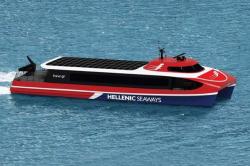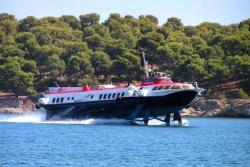'Flying Dolphins' To Retire
 Hellenic Seaways announced that they have ordered three new catamaran passenger ships that will replace their old beloved 'Flying Dolphins'. The ageing fleet of 'Flying Dolphins' have served destinations in the Saronic Gulf for more than forty years and it is time these old hydrofoils, built in Russia/Ukraine, were replaced. Hellenic Seaways, created in 2005 as an Attica Group subsidery, has ordered three 150-seat vessels designed and made in Norway and expect these catamarans to start replacing the old hydrofoils by July 2022. These new aero-catamarans are bigger, quicker, environmentally friendly with low carbon emissions and have solar panels to provide the ship's electricity. The Saronic Gulf is one of the most beneficial routes in the country, serving popular destinations such as Aegina, Poros, Hydra, Ermioni, Spetses and Porto Heli, which have a much longer tourist season.
Hellenic Seaways announced that they have ordered three new catamaran passenger ships that will replace their old beloved 'Flying Dolphins'. The ageing fleet of 'Flying Dolphins' have served destinations in the Saronic Gulf for more than forty years and it is time these old hydrofoils, built in Russia/Ukraine, were replaced. Hellenic Seaways, created in 2005 as an Attica Group subsidery, has ordered three 150-seat vessels designed and made in Norway and expect these catamarans to start replacing the old hydrofoils by July 2022. These new aero-catamarans are bigger, quicker, environmentally friendly with low carbon emissions and have solar panels to provide the ship's electricity. The Saronic Gulf is one of the most beneficial routes in the country, serving popular destinations such as Aegina, Poros, Hydra, Ermioni, Spetses and Porto Heli, which have a much longer tourist season.
 'Flying Dolphins' first appeared in Greece under the historic Ceres Flying Dolphins name (which was the first company to operate hydrofoils in Greece) controlled by the Greek shipowner Georgos Livanos. Livanos brought a new revolution to Greek sea travel by deploying two newly-built hydrofoils ahead of the Summer of 1976. These 'Flying Dolphins' originally linked Zea-Aegina-Agistri-Poros-Hydra-Ermioni-Spetses-PortoHeli-Nafplio-Tolo-Tyros-Leonidio-Kyparissia-Gerakas, serving the Saronic Gulf, the Argolic Gulf and the Eastern Peloponnese. Regardless of recurrent engine failures experienced by hydrofoils over the last four decades, the Ceres Flying Dolphins acquired a major part of the market share and remained unmatched for their fast and frequent service until the late 1980's.
'Flying Dolphins' first appeared in Greece under the historic Ceres Flying Dolphins name (which was the first company to operate hydrofoils in Greece) controlled by the Greek shipowner Georgos Livanos. Livanos brought a new revolution to Greek sea travel by deploying two newly-built hydrofoils ahead of the Summer of 1976. These 'Flying Dolphins' originally linked Zea-Aegina-Agistri-Poros-Hydra-Ermioni-Spetses-PortoHeli-Nafplio-Tolo-Tyros-Leonidio-Kyparissia-Gerakas, serving the Saronic Gulf, the Argolic Gulf and the Eastern Peloponnese. Regardless of recurrent engine failures experienced by hydrofoils over the last four decades, the Ceres Flying Dolphins acquired a major part of the market share and remained unmatched for their fast and frequent service until the late 1980's.
In 1991, Ceres Flying Dolphins introduced their first FlyingCat catamaran on the Flisvos-Poros-Hydra-Ermioni-Spetses-PortoHeli line, while also operating from Piraeus and Zea on occasions. Becoming the new flagship of the company, the FlyingCat was far larger and faster than hydrofoils, featuring many more amenities compared to the 'dolphins'. In 1999, Ceres experienced an unexpected event which eventually forced it to shut down its operations. The other giant operator, Minoan Lines, bought the entire stake in Ceres Flying Dolphins to create a new empire, rebranded to Minoan Flying Dolphins. During early Summer of 2000, Minoan Flying Dolphins had become the main operator in the Aegean, including the Argo-Saronic Gulf and the Sporades, operating from the large port of Piraeus.
 In August 2000, tragedy struck, the company's Flying Dolphin V suffered a major fire which completely destroyed her. On 26th September, the conventional ferry MS Express Samina, of Hellas Ferries (owned by Minoan) sank near Paros resulting in the loss of 82 people. Only two days later, the Express Artemis suffered a blackout in Naxos whilst carrying 1000 passengers. As a result the Greek Government 'confiscated' all Greek operated ships, with many being laid up until they would meet strict national safety standards. Due to the huge costs involved, many ships, ferries and hydrofoils were scrapped. In 2002 the Minoan Flying Dolphins company was renamed to Hellas Flying Dolphins, but most of their services began to decrease. In the Argo-Saronic Gulf, sailings to Nafplio and beyond were cancelled.
In August 2000, tragedy struck, the company's Flying Dolphin V suffered a major fire which completely destroyed her. On 26th September, the conventional ferry MS Express Samina, of Hellas Ferries (owned by Minoan) sank near Paros resulting in the loss of 82 people. Only two days later, the Express Artemis suffered a blackout in Naxos whilst carrying 1000 passengers. As a result the Greek Government 'confiscated' all Greek operated ships, with many being laid up until they would meet strict national safety standards. Due to the huge costs involved, many ships, ferries and hydrofoils were scrapped. In 2002 the Minoan Flying Dolphins company was renamed to Hellas Flying Dolphins, but most of their services began to decrease. In the Argo-Saronic Gulf, sailings to Nafplio and beyond were cancelled.
 Hellas Flying Dolphins underwent another strategic rebuild in 2005, when the new company Hellenic Seaways was formed. All ships from the former divisions now operated under the new company name, with several old ferries scrapped or sold to other operators. Hellenic Seaways did not priorities the services of their hydrofoils and many were withdrawn from service. Hellenic Seaways maintained a strong presence in the Saronic Gulf, however, from 2008 to 2011, a hydrofoil had to be retired each year due to her reaching the age limit of 30 years service. Only two of the three remaining 'Flying Dolphins' operate on the Saronic service between Piraeus-Poros-Hydra-Ermioni-Spetses-PortoHeli, reflecting the decline of hydrofoils in Greece. It will be interesting to see if the Flying Dolphin name survives in 2022.
Hellas Flying Dolphins underwent another strategic rebuild in 2005, when the new company Hellenic Seaways was formed. All ships from the former divisions now operated under the new company name, with several old ferries scrapped or sold to other operators. Hellenic Seaways did not priorities the services of their hydrofoils and many were withdrawn from service. Hellenic Seaways maintained a strong presence in the Saronic Gulf, however, from 2008 to 2011, a hydrofoil had to be retired each year due to her reaching the age limit of 30 years service. Only two of the three remaining 'Flying Dolphins' operate on the Saronic service between Piraeus-Poros-Hydra-Ermioni-Spetses-PortoHeli, reflecting the decline of hydrofoils in Greece. It will be interesting to see if the Flying Dolphin name survives in 2022.
Since their first introduction to Greek waters in 1976, the 'Flying Dolphins' have been used by hundreds of millions of passengers, both Greeks and tourists from around the world, using these hydrofoils to reach different coastal and island destinations throughout Greece. The Saronic islands are the closest islands to Piraeus, the main port of Athens, making them the ideal short-break destination for millions of Athenians and global travellers. Traditionally, people living in the greater Athens area make their escape to these Saronic coastal destinations for a quick and relaxing break, even if it's just for a night or two. It has been noted that approximately three million passengers have used these hydrofoils on the route between Piraeus and the Saronic islands, in addition to Ermioni and Porto Heli, every year.
As these 'Flying Dolphins' were originally only designed to travel on the long wide rivers of Russia and Ukraine, as well as coastal destinations around the Black Sea, they were very suspect to the strong Aegean winds when travelling on the Greek open seas. There will be many passengers that have 'fond' memories of such trips, but this was part of their lasting charm. 'An end of an era'.
'Flying Dolphin' details - Length:34.5m Width:5.8m Draught:4.2m Gross tonnage:162 Speed:33.5 knots Passengers:128